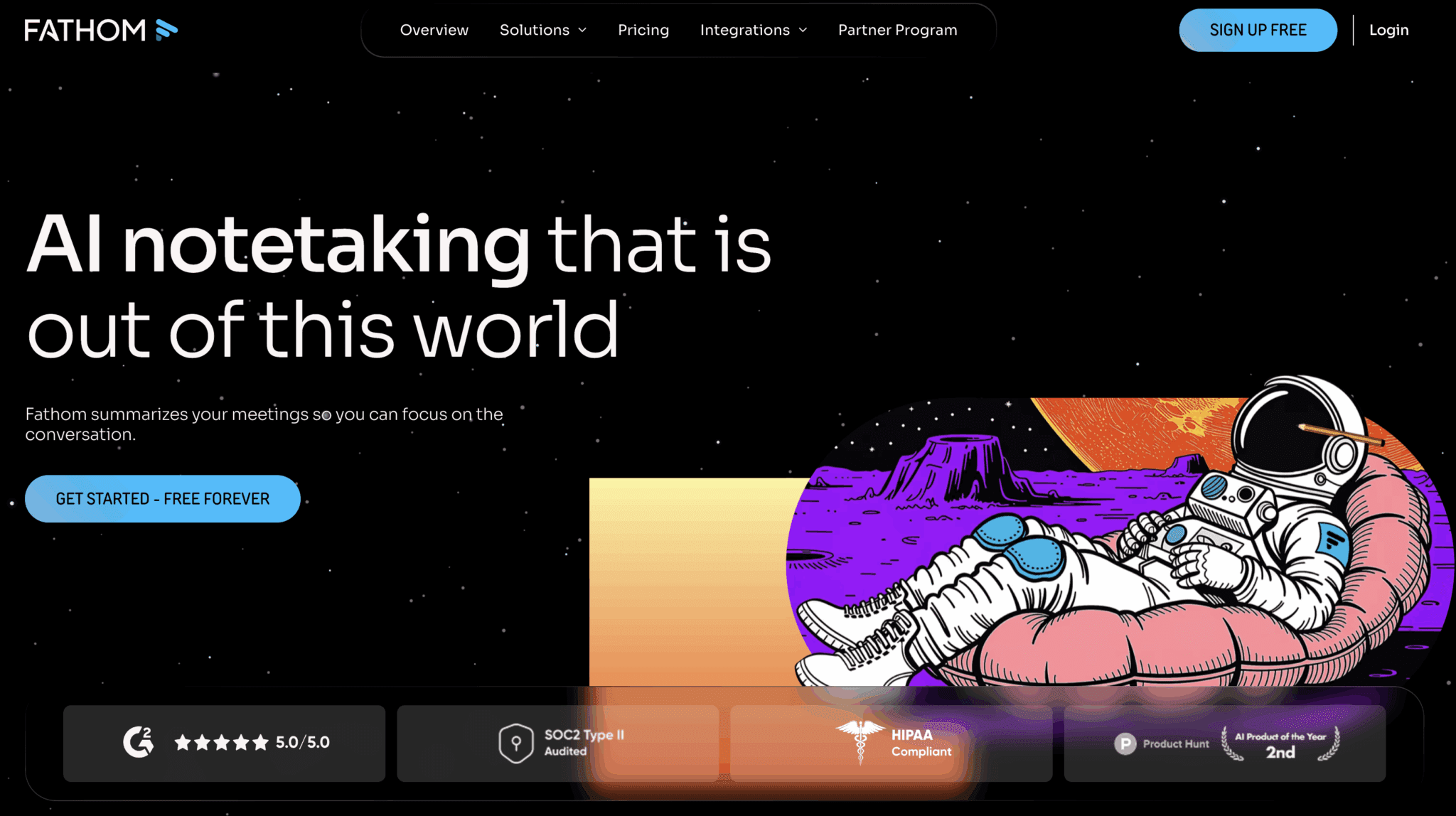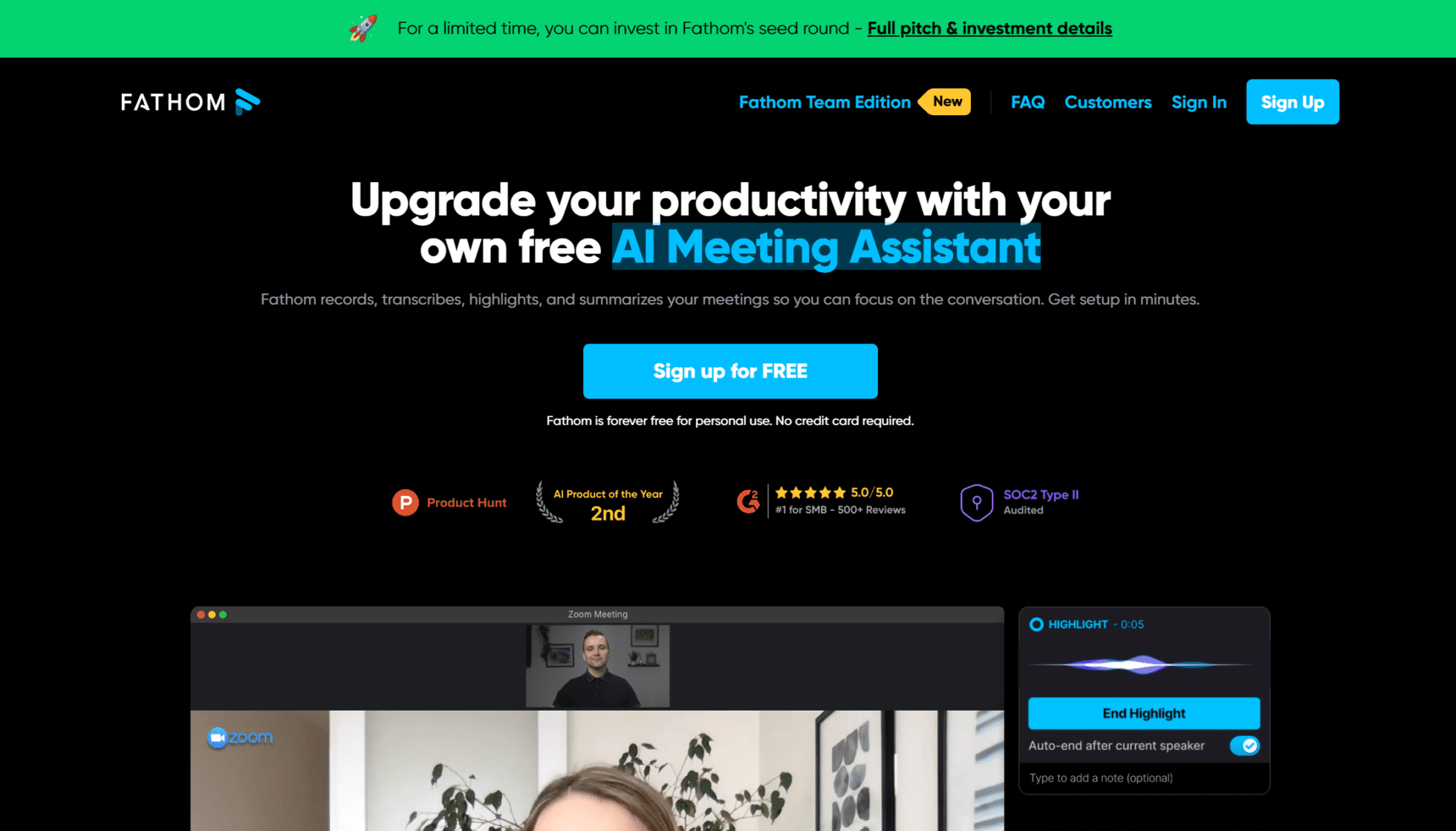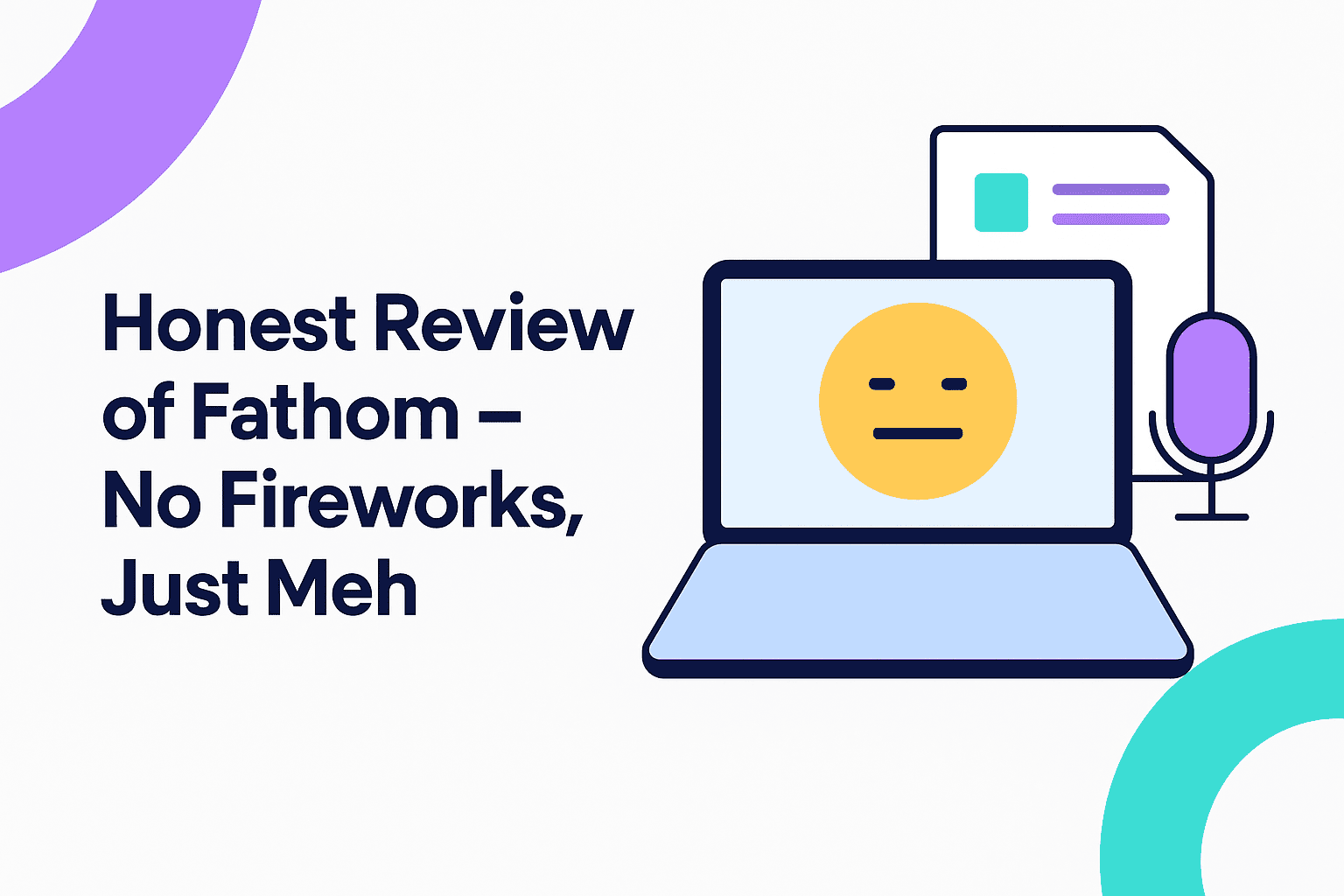Fathom has been open on both my laptop and desktop for months, quietly judging me while I tried to decide if I actually liked it. Not actively doing anything. Not annoying. Just… present. Watching. Hovering like an AI intern waiting for direction. I’d glance at the icon in my taskbar and feel that familiar flicker of guilt, like I owed it something. A test. An honest review of Fathom. An opinion. A page in my diary. Just… something.
And truthfully, I’ve been circling this review for a while. Because it’s not that I hated it. But I also didn’t love it. I kept thinking, surely there’s more? Surely if I just used it a bit more, pushed it a little further, it would reveal something brilliant. Something worth shouting about. Something that would make me ditch tl;dv and say, “Right, that’s it. This is the one.”
But it never really happened. It just kept working. Fine. Polite. Functional. Like a spreadsheet that takes meeting notes.

Before I get into the nuts and bolts of this honest review of Fathom, you may be wondering… who is this woman and why should I listen to her? Fair question.
I’m a copywriter. I run a business, collaborate with agencies, and spend a lot of time in meetings that end with someone saying, “Can you just send a quick recap?” I’ve tested more AI tools than most people even know exist, not because I collect them, but because I want something that actually helps. I write for tl;dv, so I live and breathe this space most days. But even if I didn’t, I’d still be sitting there pulling apart how these tools work. That’s just how my brain is wired.
These tools are starting to embed themselves into how we work, and I think it matters whether they’re actually pulling their weight. Some aren’t. So while this is an honest review of Fathom, it’s not a teardown. It’s not a walkthrough either. It’s a proper, real-world review. The kind you write after using something for a bit. Not just opening it once, clicking around, and calling it intuitive.
TL;DR Honest Fathom Review
Fathom is an AI meeting assistant that records, transcribes, and summarizes your calls. It works. It’s tidy. It stays out of your way.
But it also doesn’t really do anything that lifts your workflow. The summaries are clean but stiff. The features are there, but not exactly thrilling. And the vibe? Slightly emo, mostly beige.
It’s good if you just want something to quietly take notes and disappear.
It’s less helpful if you’re looking for context, flexibility, or something that feels like part of your team.
Think of it like Notepad with a built-in mic. Reliable. But forgettable.
Read on for more, or jump straight to the Fathom Pricing Calculator.
What Is Fathom?
We all know Notion. We all know Gong. Fathom feels less like them, more like a smaller ship trying to find its sea. So I looked up who’s steering.
Fathom was started in 2020 by Richard White. White’s not a scrub. He built UserVoice before this, so he knows product, feedback loops, expectations. But also, founding something in 2020 and now being pretty visible means this has had time to grow (and look polished).
In early 2022, they scored a seed round of about $4.7 million. Then, in September 2024 they raised $17 million. The usual VCs showed up. But here’s the twist: over $2 million of that came from regular users via crowdfunding. That tells me a few people believe in it enough to put cash behind it. Maybe they like it. Maybe they want what it says it could be.
But: despite the fancy homepage and the fancy branding (astronauts, space stuff, big UX moves), the core feels the same: A lean tool built to do one thing.
The big vision, from what I saw, is to become the “meeting intelligence layer”, i.e. not just note taking, but surfacing insight, decisions, action items, maybe even automating follow‑ups. That’s canon in the investor announcements.

My Honest Review of Fathom: First Impressions To Now
The first time I used Fathom was almost three years ago. It would turn up in your call (only Zoom at that time) and transcribe. That was about it. Summaries were sort of there. No insight.
At that time, we weren’t writing detailed comparisons; we were just poking around the space, trying things to see how they compared. Fathom existed, but it didn’t demand attention. I didn’t forget about it completely. The name popped up now and then, a tweet here, a mention there. But it wasn’t part of my day-to-day. However over the recent years, we’ve delved a little deeper, and in fact you may have already read our tl;dv vs Fathom, and Fathom Alternatives post.
So, my experience with Fathom changed when I sat down to write this. I figured if I was going to be honest about the current landscape, I needed to test it properly. So I downloaded the desktop app. Let it live in the taskbar.
For a while, it didn’t do much. The icon sat there. I opened it a few times, clicked around, then closed it again. I wasn’t sure if I was avoiding it or just not that interested. Either way, it never felt urgent.
Eventually, I used it on a proper call. Then another. Mostly Google Meet. A couple of Zooms. Some softer calls with collaborators where things drifted off script. It worked. It joined the meeting. It took notes. It sent me a summary. Nothing broke. But nothing really stood out.
It did the job…. and that’s about it.

Fathom: Features and What You Actually Get
So the gist is that Fathom is an AI-powered meeting assistant built to record, transcribe, and summarize video calls. It works with Zoom, Google Meet, and Microsoft Teams. You connect your calendar and it joins scheduled calls automatically.
Afterwards, you get:
- A full transcript with speaker labels
- A short AI summary
- Time-stamped playback linked to the transcript
- Shareable clips
- Highlights of questions asked – both yours and theirs
- Your “Action Items”
- A list of attendees
- Buttons to share this with other participants
- The option to ask questions through “Ask Fathom”


It integrates with tools like HubSpot and Salesforce. There are team-level features like shared libraries, keyword tracking, and basic cross-meeting insights. You can apply templates to summaries after the call.
In my case, I mostly stuck with Google Meet, and I downloaded something that means that Fathom now appears as a button in the interface. It used to float as a pop-up on my desktop as well.
The summaries arrive quickly. They’re clean, but formal. If you work in a structured setting, that might suit you. I ended up tweaking them to sound less stiff. The transcripts are accurate. I found them useful when I needed to check something after a meeting without replaying the whole thing.
There’s no tone adjustment. No obvious way to set how you want the summary to sound. The features feel fixed. Reliable, but not flexible.
| Feature | Details |
|---|---|
| Supported Platforms | Zoom, Google Meet, Microsoft Teams |
| Recording & Transcription | Auto-joins calls via calendar integration, captures audio, generates transcripts with speaker labels |
| Meeting Summaries | Short, structured summaries generated post-call; tone is formal, no obvious customization for voice |
| Summary Templates | Available post-call, mostly for paid users; no pre-call templating or tone control |
| “Ask Fathom” | Lets you query past meetings using natural language; works best on recent, structured content |
| Multi-Meeting Insights | Available in team plans; offers keyword tracking and global search, though not surfaced intuitively |
| Integrations | Native integrations with HubSpot, Salesforce, and Slack; other tools require Zapier or manual export |
| Free Plan | Unlimited recordings and transcripts; basic summaries only after five meetings per month |
| Paid Plans | Premium starts at ~$20/month; Team and Business tiers add insights, admin controls, and reporting |
Real Calls, Real Glitches: Where Fathom Fell Short
I didn’t test Fathom in a sandbox. I used it on actual calls. Proper, messy, real-world meetings where I needed to be present, remember what was said, and ideally not end up rewriting half the notes afterwards.
The One Where We Had a Clear Agenda and It Still Got Confused
One call was with a contractor. We were working on two completely separate deliverables for the same client. The agenda was clear: first half for one project, second half for the other. No tangents. No crossover. Probably the most structured call I’ve had all year.
Fathom blurred it all together. The summary jumbled the flow, mixed up the tasks, and made the whole conversation look scattered. If I’d sent those notes to someone outside the call, they would have assumed we didn’t know what we were doing.
We did. Fathom just didn’t catch the structure.
The One Where It Crashed My Therapy Session
Bit of an overshare here but I joined my therapy session like I normally would. What I forgot was that Fathom was still connected to my calendar. My therapist admitted the bot, assuming I’d asked for the session to be recorded.
I hadn’t.
I didn’t even realise it had joined until that little floating window appeared in the corner of the screen. I asked for my therapist to eject it immediately. Nothing was saved, but still, not a moment you want quietly transcribed.
To be clear, this wasn’t a bug. It was just what happens when you install a tool, give it calendar access, and don’t adjust the settings. But it’s also a reminder that just because something is technically private, doesn’t mean it’s behaving with any awareness.
It didn’t mean to be invasive. But it was.
So if you’re ever on a call and Fathom suddenly suggests that your inability to enforce client boundaries might be connected to childhood stuff, you can thank me. That data point may have come from my session.
The One Where I Needed It to Impress Someone… and It Didn’t
This was a call with a brand-new client’s external interviewee. Not someone I’d worked with before. It was an important rapport-building session. One of those conversations where tone matters more than bullet points.
Fathom captured the basics. The transcript was clean, and the summary looked fine at first glance. But it missed everything that actually mattered. The nuance, the energy, the offhand comments that tell you what someone’s really saying. It was technically accurate, but emotionally flat.
I didn’t expect it to get everything. But I needed it to catch something beyond the surface. It didn’t.
How Much Does Fathom Cost in 2025?
We have a slightly more in-depth guide on Fathom’s Pricing, but here is a quick sumary. There’s a free version. And I’ll be honest, it’s a decent one. You get unlimited recordings and transcripts, plus summaries on every call. The catch is that only five of those summaries each month are the advanced, polished kind. After that you are back to the basic version.
Like most tools in this space, the moment you want more control, whether that is over how summaries are written, how action items are flagged, or how everything ties into your stack, you need to pay.
Here’s the current breakdown:
Free: Unlimited recordings and transcripts, five advanced summaries per month, plus the basic recap on everything else.
Premium (Solo): $20 per month. Unlocks unlimited advanced summaries, “Ask Fathom,” action items, and more flexibility.
Team: $18 per user, per month (two-user minimum). Adds shared libraries, folders, comments, and global search across all calls.
Business: $28 per user, per month (two-user minimum). Brings in coaching metrics, CRM field sync, keyword alerts, and extra admin and security controls.
They shave a bit off if you go annual. The free plan is fine for the basics. If you are in Fathom every day and want it to feel like part of your workflow rather than a bolt on, you probably need to pay.
For a full breakdown of what you can expect to pay, fill in the number of seats you want, the type of billing, and your desired plan below. Our Fathom pricing calculator will provide your estimated costs.
Fathom Pricing Calculator
What Other Users Are Saying About Fathom
Now, I could spend all day talking about how much I dislike Fathom’s slightly emo dark mode, or that I’m still not entirely convinced it isn’t listening to me mutter this review aloud while I type. But instead, I went and looked at what other actual users (the ones who aren’t writing blog posts for competitors) had to say.
I scoured G2, Trustpilot, and Reddit for the juiciest takes. Some of them confirmed what I already thought. Some of them made me go, “fair enough”. And some made me glad I wasn’t the only one having certain issues.
What People Love
“The ease of use is outstanding, it integrated seamlessly into our workflow and was simple to set up. Their excellent customer service made the process even smoother, always responsive and helpful.” – G2
“Accents – Oh my god, it is so great with folks who have a broken accent.” – G2
“Fathom is also extremely easy to use and implement based on our company’s specific privacy and security rules. Finally I found it very easy to connect to all my meeting tools, but especially the integration with Google meet is awesome and very helpful.” – G2
“Fathom’s ability to organize and present in a digestible format allows me to put down my pen or take my hands off the keyboard and listen to my prospects.” – Trustpilot
“fathom is excellent. I used to user otter, but when they upped the prices and cut the minutes, I jumped to fathom.” – Reddit
Across these platforms, people consistently praised the transcript accuracy, the quick summaries, and the fact that it mostly just does what it says it will. People who are in structured, repeatable workflows, especially in sales, finance, or ops, seem to really like it.
What Doesn’t Work for Everyone
But not everything is glowing. Several reviewers pointed out moments where Fathom dropped the ball.
“The timestamps are EXTREMELY inaccurate. Like, for a 2-3 hour Zoom call, it will show timestamps as if my call was 6 minutes. Or it will categorize things in 45 minute chunks (which are also inaccurate). “ – G2
“Instead of giving actual admin visibility (which is standard for any serious platform), their solution is: “Just log in with your employee’s Google credentials.” Yes… that was the advice. Log in as them.” – G2
“Clunky UI, absolutely terrible lagging and slowdown, incorrect transcribing, needs to be launched alongside ZOOM.” – G2
“Not very sales specific, i have tried other tools and they seem to be a better fit for my use cases.” – G2
“This has caused significant damage to my company, as I no longer have access to transcripts and files for several long-term client relationships. Fathom is taking zero accountability.” – Trustpilot
What This Tells Me
Fathom is reliable if you keep your meetings tidy. It does well with structure. It’s fast. It stays out of the way. And for a lot of people, that’s enough.
But once you need it to handle nuance, tone, or anything slightly outside the norm, it starts to feel less useful. Summaries lack detail. Control is limited. The AI doesn’t always know what to emphasise.
It’s solid. But if you’re working in a role where subtlety matters, or where you need different formats for different people, you may find yourself doing more editing than expected.
Fathom’s Late Push Into Coaching and Scorecards
As of September 25, Fathom has added a bundle of features under its Business plan called Coaching and AI Scorecards. The idea is straightforward. You build scorecards for internal calls, set criteria, and the AI grades conversations against your template. Meeting types now let admins categorize calls and apply default summaries, there is an Asana integration to push tasks across, summaries can be copied without links, and team users get AI search across calls.
On paper this is Fathom’s attempt to look more like a coaching tool rather than just a polite notetaker. It could be useful if you run a sales team and want structured feedback loops.
That said, tl;dv has had most of this for a while, so Fathom is not breaking new ground here, more catching up.
Full disclosure: this was launched after I completed my initial tests. I wanted to acknowledge it, but for transparency I have not tested these features myself. I will be keeping a close eye and will update whenever possible.
Quick-Fire Honest Review of Fathom
- Good for: accurate transcription, tidy free plan, simple workflows
- Bad for: nuance, flexibility, personality in summaries
- Pricing: free plan is generous, paid starts around $20/month
- Alternatives: tl;dv if you want something less beige and more team-ready
- Verdict: reliable but bland, like Notepad with a mic
Would I Recommend Fathom?
I love a hot take. I’ll happily write a spicy teardown if something annoys me. If you’ve read my Cluely review or the Notion AI post, you’ll know I don’t hold back when something deserves to be called out.
But this? This didn’t make me mad. It didn’t make me impressed either. It was just boring.
Fathom worked. It joined the meeting. It wrote stuff down. It emailed it back. Nothing crashed. Nothing sparked joy. It just hovered quietly in the corner of my workflow until I remembered it was there.
It didn’t enhance anything. It didn’t change how I work. It didn’t make things easier in a way that mattered. Yeah, it’s useful but it’s also just… there.
So would I recommend it? Not really. Not unless you’ve got nothing else. It’s reliable. It’s tidy. But I wouldn’t go out of my way to tell someone else to install it.
I’m uninstalling it. Not out of frustration. Just because it doesn’t offer anything more than what I have, and if anything it’s a little bit… meh.
FAQs About Fathom
What is Fathom?
Fathom is an AI meeting assistant. It records, transcribes, and summarises your calls across Zoom, Google Meet, and Microsoft Teams.
Is Fathom free?
Yes, Fathom offers a free plan with unlimited recordings and transcripts. But after five meetings per month, the summaries downgrade to a more basic version.
How much does Fathom cost if I upgrade?
The premium plan starts at about $20 per month. Team and Business tiers cost more but add features like shared libraries, admin controls, and CRM integrations.
How accurate are the transcripts in Fathom?
Transcripts are generally very accurate, with clear speaker labels. They’re good for checking details after a call without listening back.
What are the summaries in Fathom like?
Summaries are clean and structured but quite formal. There’s no option to adjust tone or customise them to your style.
Does Fathom work on all video platforms?
It works natively with Zoom, Google Meet, and Microsoft Teams. You can also connect it through calendar integration so it joins your calls automatically.
Can Fathom integrate with my other tools?
Yes, it integrates with HubSpot, Salesforce, and Slack. For anything else, you’ll need Zapier or manual exports.
Who is Fathom best for?
Fathom suits people who want simple transcription and tidy summaries without much fuss—sales teams, compliance-heavy industries, or anyone who just needs notes captured.
Who might not like Fathom?
If you want flexible summaries, different tones, or insights beyond the basics, you may find it too limited. Creative and context-heavy roles often end up editing its output.
Is Fathom better than tl;dv?
That depends on what you need. Fathom is reliable but plain. tl;dv is better if you want something more team-ready, with context, personality, and more flexible workflows.





